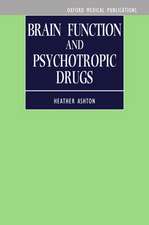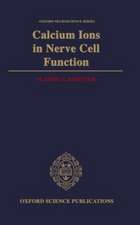Methods of Behavior Analysis in Neuroscience: Frontiers in Neuroscience
Editat de Jerry J. Buccafuscoen Limba Engleză Hardback – 29 oct 2008
Uses Animal Behavior Models to Examine Effects of Therapeutic Treatments on Human Cognition
With contributions from more than 40 field specialists, Methods of Behavioral Analysis in Neuroscience reflects six years worth of updates to its first bestselling edition and elucidates new behavioral approaches that are quickly becoming field standards. This edition features new material on the relevance of transgenic mouse models for Alzheimer’s disease, behavioral methods for assessing the cognitive impairment associated with major psychotic disorders, the revival of the scopolamine reversal model for assessing the clinical relevance of AD drugs, and approaches to assessing cognitive impairment in aged mice.
Each chapter presents theoretical background, methodology, and data interpretation, and many chapters include real-world examples of experiments that incorporate the models. With step-by-step, easy-to-reproduce methodologies, this sharply focused work covers well-studied behavioral approaches that provide a better understanding of the effects of disease and allow for better predictability of the effects of therapeutic treatments on the human cognition. It takes the guesswork out of designing the methodology for many of the most widely used animal behavioral approaches developed for the study of brain disorders, drug abuse, toxicology, and cognitive drug development.
Din seria Frontiers in Neuroscience
- 26%
 Preț: 1048.27 lei
Preț: 1048.27 lei - 18%
 Preț: 969.43 lei
Preț: 969.43 lei - 11%
 Preț: 319.88 lei
Preț: 319.88 lei - 5%
 Preț: 422.91 lei
Preț: 422.91 lei - 11%
 Preț: 320.30 lei
Preț: 320.30 lei - 12%
 Preț: 315.76 lei
Preț: 315.76 lei - 22%
 Preț: 435.02 lei
Preț: 435.02 lei - 15%
 Preț: 562.50 lei
Preț: 562.50 lei - 23%
 Preț: 456.63 lei
Preț: 456.63 lei - 15%
 Preț: 500.28 lei
Preț: 500.28 lei - 10%
 Preț: 326.59 lei
Preț: 326.59 lei -
 Preț: 462.01 lei
Preț: 462.01 lei - 5%
 Preț: 1092.97 lei
Preț: 1092.97 lei - 18%
 Preț: 1326.08 lei
Preț: 1326.08 lei - 18%
 Preț: 1342.99 lei
Preț: 1342.99 lei - 18%
 Preț: 1354.02 lei
Preț: 1354.02 lei - 18%
 Preț: 1338.34 lei
Preț: 1338.34 lei - 18%
 Preț: 1345.41 lei
Preț: 1345.41 lei - 18%
 Preț: 1333.64 lei
Preț: 1333.64 lei - 11%
 Preț: 322.18 lei
Preț: 322.18 lei - 26%
 Preț: 1014.50 lei
Preț: 1014.50 lei - 26%
 Preț: 1017.59 lei
Preț: 1017.59 lei - 26%
 Preț: 1046.00 lei
Preț: 1046.00 lei - 22%
 Preț: 323.27 lei
Preț: 323.27 lei - 26%
 Preț: 1017.08 lei
Preț: 1017.08 lei - 18%
 Preț: 1155.27 lei
Preț: 1155.27 lei - 26%
 Preț: 1016.77 lei
Preț: 1016.77 lei - 26%
 Preț: 1045.38 lei
Preț: 1045.38 lei - 26%
 Preț: 1047.77 lei
Preț: 1047.77 lei - 25%
 Preț: 995.85 lei
Preț: 995.85 lei
Preț: 1323.48 lei
Preț vechi: 1614.01 lei
-18% Nou
Puncte Express: 1985
Preț estimativ în valută:
253.47€ • 261.15$ • 212.33£
253.47€ • 261.15$ • 212.33£
Carte tipărită la comandă
Livrare economică 25 februarie-11 martie
Preluare comenzi: 021 569.72.76
Specificații
ISBN-13: 9781420052343
ISBN-10: 1420052349
Pagini: 374
Ilustrații: 87 b/w images and 12 tables
Dimensiuni: 156 x 234 x 23 mm
Greutate: 0.64 kg
Ediția:2Revizuită
Editura: CRC Press
Colecția CRC Press
Seria Frontiers in Neuroscience
Locul publicării:Boca Raton, United States
ISBN-10: 1420052349
Pagini: 374
Ilustrații: 87 b/w images and 12 tables
Dimensiuni: 156 x 234 x 23 mm
Greutate: 0.64 kg
Ediția:2Revizuită
Editura: CRC Press
Colecția CRC Press
Seria Frontiers in Neuroscience
Locul publicării:Boca Raton, United States
Public țintă
ProfessionalCuprins
Transgenic Mouse Models of Alzheimer’s Disease: Behavioral Testing and Considerations. Cued and Contextual Fear Conditioning for Rodents. Drug Discrimination. Conditioned Place Preference. Anxiety-Related Behaviors in Mice. Behavioral Assessment of Antidepressant Activity in Rodents. Assessing Attention in Rodents. The Behavioral Assessment of Sensorimotor Processes in the Mouse: Acoustic Startle, Sensory Gating, Locomotor Activity, Rotarod, and Beam Walking. Intravenous Drug Self-Administration in Nonhuman Primates. Contextually Induced Drug Seeking During Protracted Abstinence in Rats. Operant Analysis of Fronto-striatal Function in Rodents. Working Memory: Delayed Response Tasks in Monkeys. Spatial Navigation (Water Maze) Tasks. Water Maze Tasks in Mice: Special Reference to Alzheimer’s Transgenic Mice. Behavioral Neuroscience of Zebrafish. Caenorhabditis elegans Model for Initial Screening and Mechanistic Evaluation of Potential New Drugs for Aging and Alzheimer’s Disease. The Revival of Scopolamine Reversal for the Assessment of Cognition-Enhancing Drugs. Index.
Descriere
A comprehensive reference for the most well-studied behavioral approaches in animal subjects, this book examines disease effects and therapeutic treatments. The second edition features material on the relevance of transgenic mouse models for Alzheimer’s disease, behavioral methods for assessing the cognitive impairment associated with major psychotic disorders, the revival of the scopolamine reversal model for assessing the clinical relevance of new AD drugs, and new approaches for assessing cognitive impairment in aged mice. Each chapter presents theoretical background, methodology, and data interpretation.












